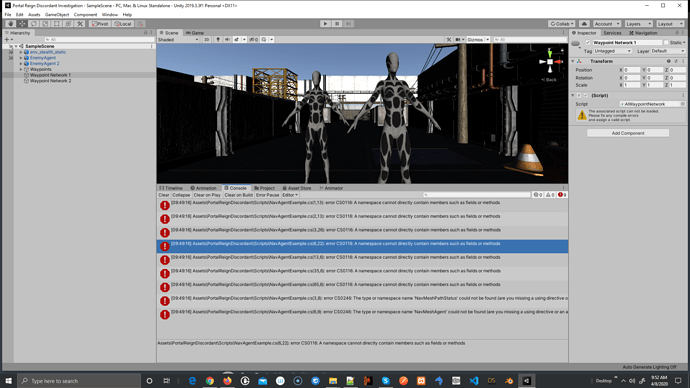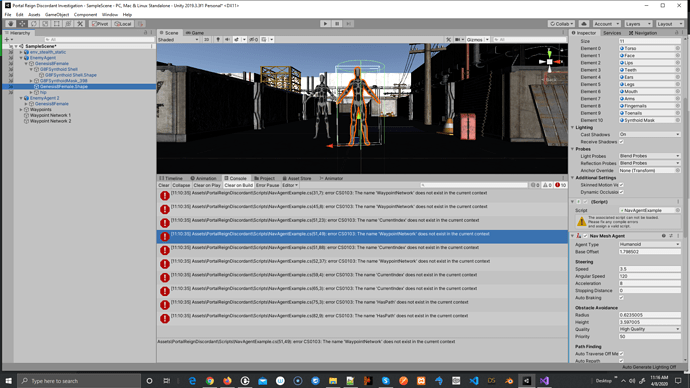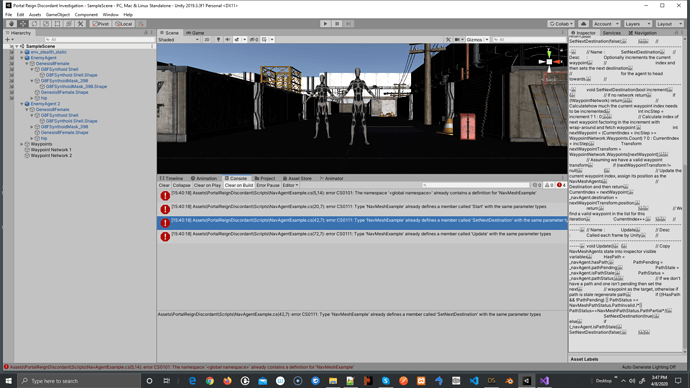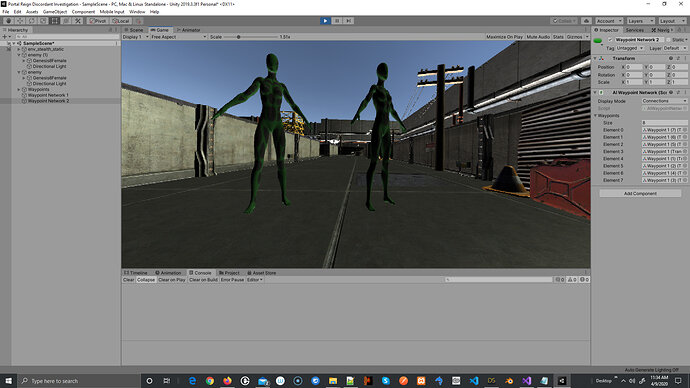Hi everyone, I receive this error during test sample scene: with 8 other errors in screenshot Any feedback is appreciated be safe everyone and stay healthy, I apologize it is not a Ben a Rick class 
Assets\PortalReignDiscordant\Scripts\NavAgentExample.cs(6,9): error CS0246: The type or namespace name ‘NavMeshAgent’ could not be found (are you missing a using directive or an assembly reference?)
Sounds like there is improper definitions in the NavAgentExample.cs script. Can I see the script in question?
Hi Riley
public bool PathPending = false;
public bool PathStale = false;
public NavMeshPathStatus PathStatus = NavMeshPathStatus.PathInvalid;
// Private Members
private NavMeshAgent _navAgent = null;
// -----------------------------------------------------
// Name : Start
// Desc : Cache MavMeshAgent and set initial
// destination.
// -----------------------------------------------------
void Start()
{
// Cache NavMeshAgent Reference
_navAgent = GetComponent<NavMeshAgent>();
// Turn off auto-update
/*_navAgent.updatePosition = false;
_navAgent.updateRotation = false;*/
// If not valid Waypoint Network has been assigned then return
if (WaypointNetwork == null) return;
SetNextDestination(false);
}
// -----------------------------------------------------
// Name : SetNextDestination
// Desc : Optionally increments the current waypoint
// index and then sets the next destination
// for the agent to head towards.
// -----------------------------------------------------
void SetNextDestination(bool increment)
{
// If no network return
if (!WaypointNetwork) return;
// Calculatehow much the current waypoint index needs to be incremented
int incStep = increment ? 1 : 0;
// Calculate index of next waypoint factoring in the increment with wrap-around and fetch waypoint
int nextWaypoint = (CurrentIndex + incStep >= WaypointNetwork.Waypoints.Count) ? 0 : CurrentIndex + incStep;
Transform nextWaypointTransform = WaypointNetwork.Waypoints[nextWaypoint];
// Assuming we have a valid waypoint transform
if (nextWaypointTransform != null)
{
// Update the current waypoint index, assign its position as the NavMeshAgents
// Destination and then return
CurrentIndex = nextWaypoint;
_navAgent.destination = nextWaypointTransform.position;
return;
}
// We did not find a valid waypoint in the list for this iteration
CurrentIndex++;
}
// ---------------------------------------------------------
// Name : Update
// Desc : Called each frame by Unity
// ---------------------------------------------------------
void Update()
{
// Copy NavMeshAgents state into inspector visible variables
HasPath = _navAgent.hasPath;
PathPending = _navAgent.pathPending;
PathStale = _navAgent.isPathStale;
PathStatus = _navAgent.pathStatus;
// If we don't have a path and one isn't pending then set the next
// waypoint as the target, otherwise if path is stale regenerate path
if ((!HasPath && !PathPending) || PathStatus == NavMeshPathStatus.PathInvalid /*|| PathStatus==NavMeshPathStatus.PathPartial*/)
SetNextDestination(true);
else
if (_navAgent.isPathStale)
SetNextDestination(false);
}
I notice just now the scripts do not have headers like this :
I will add a let you results :
using UnityEngine;
using System.Collections.Generic;
Hi Riley, I added the following lines but these line of code were created in this script Thank you for any feedback 
using UnityEngine;
using System.Collections.Generic;
public class NavMeshExample : MonoBehaviour
{
Lines of code changed after adding above
// If we don't have a path and one isn't pending then set the next
// waypoint as the target, otherwise if path is stale regenerate path
if ((!HasPath && !PathPending) || PathStatus == UnityEngine.AI.NavMeshPathStatus.PathInvalid /*|| PathStatus==NavMeshPathStatus.PathPartial*/)
SetNextDestination(true);
else
All that code is within a class or just on it’s own? Make sure you got all your closing curling brackets.
It is just on its own I believe I did check my curling brackets will check again. I following a class instructions this one:
Send the full script you have and I’ll see if I can get it sorted out.
Hi Riley, I think you ae super for this 
These are all the scripts I work with.
using UnityEngine;
using System.Collections.Generic;
// Display Mode that the Custom Inspector of an AIWaypointNetwork
// component can be in
public enum PathDisplayMode { None, Connections, Paths }
// -------------------------------------------------------------------
// CLASS : AIWaypointNetwork
// DESC : Contains a list of waypoints. Each waypoint is a
// reference to a transform. Also contains settings
// for the Custom Inspector
// ------------------------------------------------------------------
public class AIWaypointNetwork : MonoBehaviour
{
[HideInInspector]
public PathDisplayMode DisplayMode = PathDisplayMode.Connections; // Current Display Mode
[HideInInspector]
public int UIStart = 0; // Start wayopoint index for Paths mode
[HideInInspector]
public int UIEnd = 0; // End waypoint index for Paths mode
// List of Transform references
public List<Transform> Waypoints = new List<Transform>();
}
using UnityEngine;
using System.Collections;
using UnityEditor;
// ------------------------------------------------------------------------------------
// CLASS : AIWaypointNetworkEditor
// DESC : Custom Inspector and Scene View Rendering for the AIWaypointNetwork
// Component
// ------------------------------------------------------------------------------------
[CustomEditor(typeof(AIWaypointNetwork))]
public class AIWaypointNetworkEditor : Editor
{
// --------------------------------------------------------------------------------
// Name : OnInspectorGUI (Override)
// Desc : Called by Unity Editor when the Inspector needs repainting for an
// AIWaypointNetwork Component
// --------------------------------------------------------------------------------
public override void OnInspectorGUI()
{
// Get reference to selected component
AIWaypointNetwork network = (AIWaypointNetwork)target;
// Show the Display Mode Enumeration Selector
network.DisplayMode = (PathDisplayMode)EditorGUILayout.EnumPopup ( "Display Mode", network.DisplayMode );
// If we are in Paths display mode then display the integer sliders for the Start and End waypoint indices
if (network.DisplayMode==PathDisplayMode.Paths)
{
network.UIStart = EditorGUILayout.IntSlider ( "Waypoint Start" , network.UIStart, 0, network.Waypoints.Count-1);
network.UIEnd = EditorGUILayout.IntSlider ( "Waypoint End" , network.UIEnd, 0, network.Waypoints.Count-1);
}
// Tell Unity to do its default drawing of all serialized members that are NOT hidden in the inspector
DrawDefaultInspector();
}
// --------------------------------------------------------------------------------
// Name : OnSceneGUI
// Desc : Implementing this functions means the Unity Editor will call it when
// the Scene View is being repainted. This gives us a hook to do our
// own rendering to the scene view.
// --------------------------------------------------------------------------------
void OnSceneGUI()
{
// Get a reference to the component being rendered
AIWaypointNetwork network = (AIWaypointNetwork)target;
// Fetch all waypoints from the network and render a label for each one
for(int i=0; i<network.Waypoints.Count;i++)
{
if (network.Waypoints[i]!=null)
Handles.Label ( network.Waypoints[i].position, "Waypoint "+i.ToString ());
}
// If we are in connections mode then we will to draw lines
// connecting all waypoints
if (network.DisplayMode == PathDisplayMode.Connections)
{
// Allocate array of vector to store the polyline positions
Vector3 [] linePoints = new Vector3[ network.Waypoints.Count+1 ];
// Loop through each waypoint + one additional interation
for(int i=0; i<=network.Waypoints.Count;i++)
{
// Calculate the waypoint index with wrap-around in the
// last loop iteration
int index = i!=network.Waypoints.Count ? i : 0;
// Fetch the position of the waypoint for this iteration and
// copy into our vector array.
if (network.Waypoints[index]!=null)
linePoints[i] = network.Waypoints[index].position;
else
linePoints[i] = new Vector3(Mathf.Infinity, Mathf.Infinity, Mathf.Infinity);
}
// Set the Handle color to Cyan
Handles.color = Color.cyan;
// Render the polyline in the scene view by passing in our list of waypoint positions
Handles.DrawPolyLine ( linePoints );
}
else
// We are in paths mode so to proper navmesh path search and render result
if (network.DisplayMode == PathDisplayMode.Paths)
{
// Allocate a new NavMeshPath
UnityEngine.AI.NavMeshPath path = new UnityEngine.AI.NavMeshPath();
// Assuming both the start and end waypoint indices selected are ligit
if (network.Waypoints[network.UIStart]!=null && network.Waypoints[network.UIEnd]!=null)
{
// Fetch their positions from the waypoint network
Vector3 from = network.Waypoints[network.UIStart].position;
Vector3 to = network.Waypoints[network.UIEnd].position;
// Request a path search on the nav mesh. This will return the path between
// from and to vectors
UnityEngine.AI.NavMesh.CalculatePath ( from, to, UnityEngine.AI.NavMesh.AllAreas, path );
// Set Handles color to Cyan
Handles.color = Color.cyan;
// Draw a polyline passing int he path's corner points
Handles.DrawPolyLine( path.corners );
}
}
}
}
// -----------------------------------------------------
// Name : SetNextDestination
// Desc : Optionally increments the current waypoint
// index and then sets the next destination
// for the agent to head towards.
// -----------------------------------------------------
void SetNextDestination(bool increment)
{
// If no network return
if (!WaypointNetwork) return;
// Calculatehow much the current waypoint index needs to be incremented
int incStep = increment ? 1 : 0;
// Calculate index of next waypoint factoring in the increment with wrap-around and fetch waypoint
int nextWaypoint = (CurrentIndex + incStep >= WaypointNetwork.Waypoints.Count) ? 0 : CurrentIndex + incStep;
Transform nextWaypointTransform = WaypointNetwork.Waypoints[nextWaypoint];
// Assuming we have a valid waypoint transform
if (nextWaypointTransform != null)
{
// Update the current waypoint index, assign its position as the NavMeshAgents
// Destination and then return
CurrentIndex = nextWaypoint;
_navAgent.destination = nextWaypointTransform.position;
return;
}
// We did not find a valid waypoint in the list for this iteration
CurrentIndex++;
}
// ---------------------------------------------------------
// Name : Update
// Desc : Called each frame by Unity
// ---------------------------------------------------------
void Update()
{
// Copy NavMeshAgents state into inspector visible variables
HasPath = _navAgent.hasPath;
PathPending = _navAgent.pathPending;
PathStale = _navAgent.isPathStale;
PathStatus = _navAgent.pathStatus;
// If we don't have a path and one isn't pending then set the next
// waypoint as the target, otherwise if path is stale regenerate path
if ((!HasPath && !PathPending) || PathStatus == UnityEngine.AI.NavMeshPathStatus.PathInvalid /*|| PathStatus==NavMeshPathStatus.PathPartial*/)
SetNextDestination(true);
else
if (_navAgent.isPathStale)
SetNextDestination(false);
}
}
Okay I think my next question is all this code in a single file or seperate files?
I apologize for that will separate got a phone call from client had to stop what I was doing hold on.
using UnityEngine;
using System.Collections.Generic;
// Display Mode that the Custom Inspector of an AIWaypointNetwork
// component can be in
public enum PathDisplayMode { None, Connections, Paths }
// -------------------------------------------------------------------
// CLASS : AIWaypointNetwork
// DESC : Contains a list of waypoints. Each waypoint is a
// reference to a transform. Also contains settings
// for the Custom Inspector
// ------------------------------------------------------------------
public class AIWaypointNetwork : MonoBehaviour
{
[HideInInspector]
public PathDisplayMode DisplayMode = PathDisplayMode.Connections; // Current Display Mode
[HideInInspector]
public int UIStart = 0; // Start wayopoint index for Paths mode
[HideInInspector]
public int UIEnd = 0; // End waypoint index for Paths mode
// List of Transform references
public List<Transform> Waypoints = new List<Transform>();
}
using UnityEngine;
using System.Collections;
using UnityEditor;
// ------------------------------------------------------------------------------------
// CLASS : AIWaypointNetworkEditor
// DESC : Custom Inspector and Scene View Rendering for the AIWaypointNetwork
// Component
// ------------------------------------------------------------------------------------
[CustomEditor(typeof(AIWaypointNetwork))]
public class AIWaypointNetworkEditor : Editor
{
// --------------------------------------------------------------------------------
// Name : OnInspectorGUI (Override)
// Desc : Called by Unity Editor when the Inspector needs repainting for an
// AIWaypointNetwork Component
// --------------------------------------------------------------------------------
public override void OnInspectorGUI()
{
// Get reference to selected component
AIWaypointNetwork network = (AIWaypointNetwork)target;
// Show the Display Mode Enumeration Selector
network.DisplayMode = (PathDisplayMode)EditorGUILayout.EnumPopup ( "Display Mode", network.DisplayMode );
// If we are in Paths display mode then display the integer sliders for the Start and End waypoint indices
if (network.DisplayMode==PathDisplayMode.Paths)
{
network.UIStart = EditorGUILayout.IntSlider ( "Waypoint Start" , network.UIStart, 0, network.Waypoints.Count-1);
network.UIEnd = EditorGUILayout.IntSlider ( "Waypoint End" , network.UIEnd, 0, network.Waypoints.Count-1);
}
// Tell Unity to do its default drawing of all serialized members that are NOT hidden in the inspector
DrawDefaultInspector();
}
// --------------------------------------------------------------------------------
// Name : OnSceneGUI
// Desc : Implementing this functions means the Unity Editor will call it when
// the Scene View is being repainted. This gives us a hook to do our
// own rendering to the scene view.
// --------------------------------------------------------------------------------
void OnSceneGUI()
{
// Get a reference to the component being rendered
AIWaypointNetwork network = (AIWaypointNetwork)target;
// Fetch all waypoints from the network and render a label for each one
for(int i=0; i<network.Waypoints.Count;i++)
{
if (network.Waypoints[i]!=null)
Handles.Label ( network.Waypoints[i].position, "Waypoint "+i.ToString ());
}
// If we are in connections mode then we will to draw lines
// connecting all waypoints
if (network.DisplayMode == PathDisplayMode.Connections)
{
// Allocate array of vector to store the polyline positions
Vector3 [] linePoints = new Vector3[ network.Waypoints.Count+1 ];
// Loop through each waypoint + one additional interation
for(int i=0; i<=network.Waypoints.Count;i++)
{
// Calculate the waypoint index with wrap-around in the
// last loop iteration
int index = i!=network.Waypoints.Count ? i : 0;
// Fetch the position of the waypoint for this iteration and
// copy into our vector array.
if (network.Waypoints[index]!=null)
linePoints[i] = network.Waypoints[index].position;
else
linePoints[i] = new Vector3(Mathf.Infinity, Mathf.Infinity, Mathf.Infinity);
}
// Set the Handle color to Cyan
Handles.color = Color.cyan;
// Render the polyline in the scene view by passing in our list of waypoint positions
Handles.DrawPolyLine ( linePoints );
}
else
// We are in paths mode so to proper navmesh path search and render result
if (network.DisplayMode == PathDisplayMode.Paths)
{
// Allocate a new NavMeshPath
UnityEngine.AI.NavMeshPath path = new UnityEngine.AI.NavMeshPath();
// Assuming both the start and end waypoint indices selected are ligit
if (network.Waypoints[network.UIStart]!=null && network.Waypoints[network.UIEnd]!=null)
{
// Fetch their positions from the waypoint network
Vector3 from = network.Waypoints[network.UIStart].position;
Vector3 to = network.Waypoints[network.UIEnd].position;
// Request a path search on the nav mesh. This will return the path between
// from and to vectors
UnityEngine.AI.NavMesh.CalculatePath ( from, to, UnityEngine.AI.NavMesh.AllAreas, path );
// Set Handles color to Cyan
Handles.color = Color.cyan;
// Draw a polyline passing int he path's corner points
Handles.DrawPolyLine( path.corners );
}
}
}
}
using UnityEngine;
using System.Collections.Generic;
public class NavMeshExample : MonoBehaviour
{
public bool PathPending = false;
public bool PathStale = false;
public UnityEngine.AI.NavMeshPathStatus PathStatus = UnityEngine.AI.NavMeshPathStatus.PathInvalid;
// Private Members
private UnityEngine.AI.NavMeshAgent _navAgent = null;
// -----------------------------------------------------
// Name : Start
// Desc : Cache MavMeshAgent and set initial
// destination.
// -----------------------------------------------------
void Start()
{
// Cache NavMeshAgent Reference
_navAgent = GetComponent<UnityEngine.AI.NavMeshAgent>();
// Turn off auto-update
/*_navAgent.updatePosition = false;
_navAgent.updateRotation = false;*/
// If not valid Waypoint Network has been assigned then return
if (WaypointNetwork == null) return;
SetNextDestination(false);
}
// -----------------------------------------------------
// Name : SetNextDestination
// Desc : Optionally increments the current waypoint
// index and then sets the next destination
// for the agent to head towards.
// -----------------------------------------------------
void SetNextDestination(bool increment)
{
// If no network return
if (!WaypointNetwork) return;
// Calculatehow much the current waypoint index needs to be incremented
int incStep = increment ? 1 : 0;
// Calculate index of next waypoint factoring in the increment with wrap-around and fetch waypoint
int nextWaypoint = (CurrentIndex + incStep >= WaypointNetwork.Waypoints.Count) ? 0 : CurrentIndex + incStep;
Transform nextWaypointTransform = WaypointNetwork.Waypoints[nextWaypoint];
// Assuming we have a valid waypoint transform
if (nextWaypointTransform != null)
{
// Update the current waypoint index, assign its position as the NavMeshAgents
// Destination and then return
CurrentIndex = nextWaypoint;
_navAgent.destination = nextWaypointTransform.position;
return;
}
// We did not find a valid waypoint in the list for this iteration
CurrentIndex++;
}
// ---------------------------------------------------------
// Name : Update
// Desc : Called each frame by Unity
// ---------------------------------------------------------
void Update()
{
// Copy NavMeshAgents state into inspector visible variables
HasPath = _navAgent.hasPath;
PathPending = _navAgent.pathPending;
PathStale = _navAgent.isPathStale;
PathStatus = _navAgent.pathStatus;
// If we don't have a path and one isn't pending then set the next
// waypoint as the target, otherwise if path is stale regenerate path
if ((!HasPath && !PathPending) || PathStatus == UnityEngine.AI.NavMeshPathStatus.PathInvalid /*|| PathStatus==NavMeshPathStatus.PathPartial*/)
SetNextDestination(true);
else
if (_navAgent.isPathStale)
SetNextDestination(false);
}
}
Hi Riley, I was able to fix some lines of error this is was left:
Hi Riley, I removed the duplicate scripts posted in other folders unity creates that solved some errors. I also removed the NavAgentExample script this solved all errors. I will start from scratch with the NavAgentExample script maybe I can pinpoint issues. Thank you




